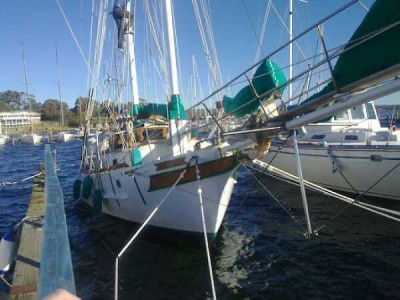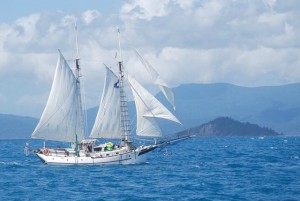
Becoming Mrs Argos
What stared out as a family sailing adventure around Australia has changed somewhat! Now its mum and the kids (now aged 17 and almost 15) working it out for themselves while cruising the Queensland coast!
24 November 2016
19 August 2016
03 August 2016
17 July 2016
21 June 2016
30 May 2016
11 May 2016
25 April 2016
09 February 2016
07 December 2015
14 October 2015
25 August 2015 | South Stradbroke Island
10 August 2015
18 July 2015
06 July 2015
15 June 2015
04 May 2015
24 April 2015
11 April 2015 | Southport
01 April 2015 | Southport
Safety at Sea!
26 August 2011 | Albany West Australia
Sue Watt

One of the biggest concerns that cruising sailors have to deal with is the issue of what to do if someone goes overboard whilst out - especially in big seas.
As part of the skippers ticket, Peter and I had to master the man-overboard manoeuvre - it's tricky and although we could perform the manoeuver sufficiently for the test, everyone we speak to tells us that out at sea and when the weather is heavy, it is so much harder.
The more we read the more we are convinced that the best way to deal with the situation is to no ever allow it to happen - to lose someone overboard is a risk we are unwilling to take.
In a recent edition of Sails Magazine there was an excellent article titled 'Left For Dead', by Nancy Knudsen identifying several practices which could really minimise the risk. It was a really good read and really helped us to identify ways in which we could establish better practices to reduce the risks for ourselves.
The main point in the article is for all crew members to wear safety harnesses at all times when on deck.
We already had a policy about the use of harnesses whenever we were in heavy weather - but this article pointed out, very validly, that when the weather whips us there is enough going on already - enough to deal with - remembering to at this point attach a harness is simply one more thing to think about. The article suggested that if a harness was used as a routine element of being on deck then it became a habit and not some additional thing to remember. For us, sailing with children, this added a degree of safety, which, quite frankly, satisfied my mother-heart more than anything else we have discussed about safety the entire time!
We had four harnesses. Today we have spent time ensuring that each person has a harness that is dedicated to them, adjusted to fit them perfectly and in addition, has two clip points. Our harnesses originally had only one point at which they could be tethered, meaning that to move from one point on deck to another you have to unclip and for that moment not be clipped on at all. The double clip system ensures that you are clipped on at all times and moving about on deck is no longer potentially a life-threatening hazard.
Our rule is that the harness is stored below deck and you are not allowed to come up on deck without first putting it on. When leaving the safety of the companionway you must first clip on to a strong point in the cockpit. Then even in the cockpit you stay clipped on. If you must leave the cockpit, which you only do if necessary in heavy weather - and for us - only Peter or I do so - you must use the double clips and remain clipped at all times.
While it is a basic requirement that our yacht is equipped with the appropriate gear for retrieving a man overboard, and that we are confident of using them and competent, the truth is that even for the most experienced sailors the chances of a successful retrieval are low. We don't want to be amongst the statistics.
The article suggested a few other safety practices which are such good sense and I loved them - never go out of the cockpit (especially on night watches) unless another crew member is awake and in the cockpit. The author spoke of situations where one crew member was on watch alone, went overboard and the other crew member was blissfully asleep and unaware of the situation. Because the boat sails with auto pilot it might be hours before another crew member is aware of the problem - by which time it's is simply too late to find the missing person.
When working on deck make sure that you are tethered short enough that if a wave takes you, you will not go overboard. Our harness tethers were too long. We have now shortened them.
Lastly, never climb the mast without an extra safety line attached.
These things might seem like pedantic and over-the-top measures - but to me, well it simply makes sense to err on the side of caution.
I particularly liked the suggestion that by doing this at all times and not as a secondary and additional practice for heavy weather.
Before we left Canberra Peter told me that losing someone overboard was not an option. Now I feel that we have all the resources and skills to ensure that that is actually possible.
As part of the skippers ticket, Peter and I had to master the man-overboard manoeuvre - it's tricky and although we could perform the manoeuver sufficiently for the test, everyone we speak to tells us that out at sea and when the weather is heavy, it is so much harder.
The more we read the more we are convinced that the best way to deal with the situation is to no ever allow it to happen - to lose someone overboard is a risk we are unwilling to take.
In a recent edition of Sails Magazine there was an excellent article titled 'Left For Dead', by Nancy Knudsen identifying several practices which could really minimise the risk. It was a really good read and really helped us to identify ways in which we could establish better practices to reduce the risks for ourselves.
The main point in the article is for all crew members to wear safety harnesses at all times when on deck.
We already had a policy about the use of harnesses whenever we were in heavy weather - but this article pointed out, very validly, that when the weather whips us there is enough going on already - enough to deal with - remembering to at this point attach a harness is simply one more thing to think about. The article suggested that if a harness was used as a routine element of being on deck then it became a habit and not some additional thing to remember. For us, sailing with children, this added a degree of safety, which, quite frankly, satisfied my mother-heart more than anything else we have discussed about safety the entire time!
We had four harnesses. Today we have spent time ensuring that each person has a harness that is dedicated to them, adjusted to fit them perfectly and in addition, has two clip points. Our harnesses originally had only one point at which they could be tethered, meaning that to move from one point on deck to another you have to unclip and for that moment not be clipped on at all. The double clip system ensures that you are clipped on at all times and moving about on deck is no longer potentially a life-threatening hazard.
Our rule is that the harness is stored below deck and you are not allowed to come up on deck without first putting it on. When leaving the safety of the companionway you must first clip on to a strong point in the cockpit. Then even in the cockpit you stay clipped on. If you must leave the cockpit, which you only do if necessary in heavy weather - and for us - only Peter or I do so - you must use the double clips and remain clipped at all times.
While it is a basic requirement that our yacht is equipped with the appropriate gear for retrieving a man overboard, and that we are confident of using them and competent, the truth is that even for the most experienced sailors the chances of a successful retrieval are low. We don't want to be amongst the statistics.
The article suggested a few other safety practices which are such good sense and I loved them - never go out of the cockpit (especially on night watches) unless another crew member is awake and in the cockpit. The author spoke of situations where one crew member was on watch alone, went overboard and the other crew member was blissfully asleep and unaware of the situation. Because the boat sails with auto pilot it might be hours before another crew member is aware of the problem - by which time it's is simply too late to find the missing person.
When working on deck make sure that you are tethered short enough that if a wave takes you, you will not go overboard. Our harness tethers were too long. We have now shortened them.
Lastly, never climb the mast without an extra safety line attached.
These things might seem like pedantic and over-the-top measures - but to me, well it simply makes sense to err on the side of caution.
I particularly liked the suggestion that by doing this at all times and not as a secondary and additional practice for heavy weather.
Before we left Canberra Peter told me that losing someone overboard was not an option. Now I feel that we have all the resources and skills to ensure that that is actually possible.
Comments
| Vessel Name: | Argos |
| Vessel Make/Model: | Gaff Rig Schooner designed by Jay Benford, built by Jack Stolp |
| Hailing Port: | Albany WA |
| Crew: | Sue Parry-Jones, Erina and Liam Jones and Capt'n Jack Sparrow! |
| About: | |
| Extra: | |
| Home Page: | www.becomingmrsargos.weebly.com |
| Social: |
Gallery not available
Becoming Mrs Argos

Who: Sue Parry-Jones, Erina and Liam Jones and Capt'n Jack Sparrow!
Port: Albany WA
